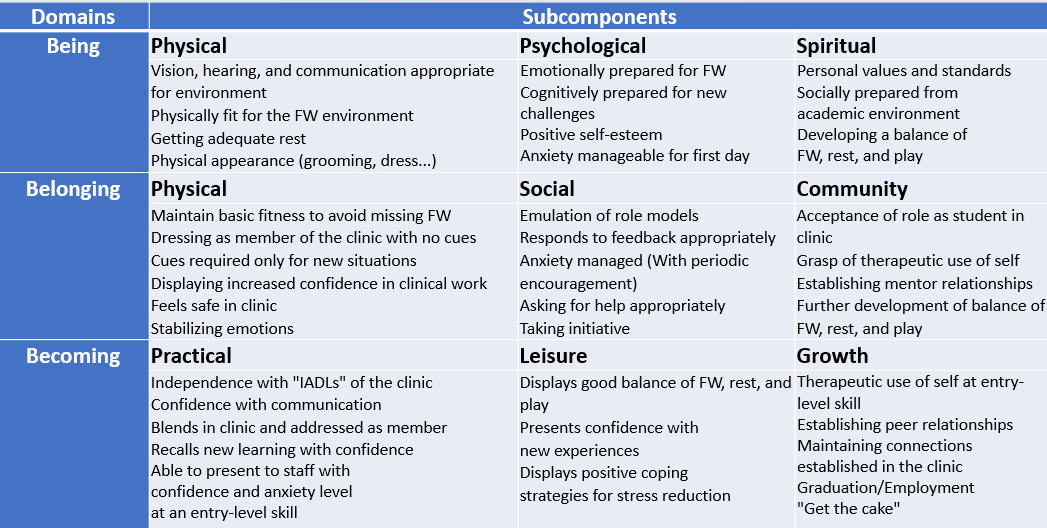The Proposed Problem…
Students begin healthcare clinical experiences with high anxiety and low confidence (Moscaritolo, 2009).
Addressing student well-being during clinical experiences and the quality of the student/supervisor relationship are important factors in developing confidence and lessening anxiety (Laidlaw, 2009; Cook, 2005).
While FW is frequently mentioned in the literature, the student’s perspective is rarely the primary focus (Lew, Cara, & Richardson, 2007).
Minimal literature exists in OT specifically addressing student anxiety and confidence during Level II FW (Taylor, Lee, Kiehlofner, & Ketkar, 2009; Bolding te al, 2020).
Increased focus is being placed on the long-term effects bullying and microaggressions (Wolke & Lareya, 2015)
Surprising given the focus occupational therapy places on QOL!
-
Addressing the effort placed into the quality of the relationship between the FW student and FWE may result in improved preparedness and confidence in our entry-level practitioners
-
Positive self-regard
Self-awareness
Interpersonal competence
Commitment to learning
-
Lack of support by management due to pressures to meet productivity demands
Personality conflicts between FW student and FW educator
What is Quality of Life?
Variables include:
Life satisfaction
Well-being
Opportunities for growth
Mastery of skills
Social networking
Social support
There is no single definition of QoL:
Dependent on the perspectives of the individual or group
Need to define the needs of the group or individual to determine what QoL needs to be
“The degree to which an individual enjoys the important possibilities of his or her life”
Quality of Life Research Unit of the Center for Health Promotions defines it as (2012):
The Fieldwork Quality of Life (FWQoL) merges concepts of:
The Intentional Relationship Model (IRM)
Adult Learner Theory
Social Cognitive Theory
The Quality-of-Life Model
3B Theory of Being, Belonging, Becoming
To give an Intentional Focus of quality of the relationship between the FWE and the FW student.
Increased personal awareness of the Intentional Relationship Model by the FWE in establishing a relationship with a FW student may result in decreasing student anxiety and increasing confidence.
1) The Intentional Relationship Model (IRM)
Comprised of 6 Therapeutic Modes:
Advocating
Collaborating
Empathizing
Encouraging
Instructing
Problem-Solving
Applying Social Cognitive Theory
Address the nature by which humans process information and function in society
An individual learns through the observations of other humans in their social contexts
Triadic reciprocal causation… (Bandura, 2001)
-
self-expectations and self-perception
-
physical environment, social modeling, and peer persuasion
-
Responses to individual and environmental stressors
Self-efficacy also plays into the process
Social Cognition Within the Fieldwork Quality of Life
The Quality of Life Model
Developed from the Center for Health Promotion (in partnership with the U. of Toronto’s OT department)
A need to belong in both a physical and social context
High quality of life results from experiencing satisfaction with experiencing achievement of one’s actions
The model indicates the importance of an individual’s perception of control
Individuals have physical, psychological, and spiritual dimensions
Also indicate the importance of being, belonging, and becoming
3B Theory
(Quality of Life Research Unit, 2012; Gruhl, Lacarte, Boucher, & Ledrew, 2018)
-
Who one is
Covers physical, psychological, and spiritual needs
Rediscovering oneself
-
Connect with one’s environment
Includes physical, social, and community needs
-
Individual’s ability to achieve personal goals and hopes
Practical needs, acquisition of leisure, and achievement of growth
Skill development, the ability to work, and prospects of economic visibility
Knowledge Check
Instructions: Please answer the following questions to review the information discussed in the third module. Click “Submit” when finished.



